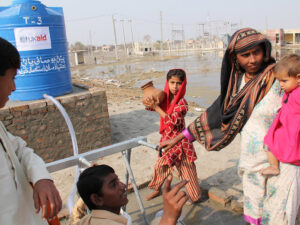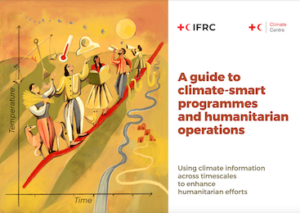Integrating Climate Risks in the Way Red Cross and Red Crescent Societies Work with Communities

Climate change impacts are exacerbating existing vulnerabilities, such as poverty, inequality and food security. Climate-related hazards, like more intense rainfall, heatwaves or droughts can therefore have severe consequences for the humanitarian sector especially in situations of disasters. To be prepared to respond to these climate risks, it is crucial to integrate climate and weather-related information into programming and planning, so called climate-smart programming (CSP). Being climate-smart is about adjusting activities and plans so they can be resilient to new weather conditions and extremes. Hence, it is important to not only integrate past climate data, but especially futurerisks and vulnerabilities should be taken into account to facilitate adaption responses. A key aspect is therefore to make use of weather forecasts (days, seasonal) and climate projections (years and decades), and building capacities of people to understand and translate this information into respective actions.
This plays a role in the area of short-term humanitarian aid e.g. when placing shelters in higher locations due to flood risk or longer-term community resilience e.g. when deciding on irrigation schemes in drought-prone areas. As seen, climate risks need to be considered in a variety of different sectors such as health, WASH, infrastructure or agriculture. It is therefore crucial to apply multi-sectoral lenses when it comes to climate-smart programming.
Climate- and Weather-Related Data Matter – but How to Collect, Interpret and Make Sense of It?
Prior to adjusting activities and plans, actors need to collect, assess as well as interpret the relevant climate and weather data. The assessment may draw on publicly available information on climate trends and projections – maybe supplemented by a specific request to national weather agencies – coupled with community risk assessment. However, this can pose several challenges to local partners in terms of accessing data from the right sources or having the capability to analyse, understand and integrate them. Therefore, they need a clear and easy-to-use guidance on how to collect relevant data or who to reach out to.
 Enhancing Guidance for National and Community Actors
Enhancing Guidance for National and Community Actors
Shedding more light on this complex issue, the International Federation of the Red Cross and Red Crescent Societies (IFRC), has published several guidances which touch upon the topic of climate-smart disaster risk reduction and programming. They strengthen a multi-sectoral perspective as well as the role of livelihood programming.
To improve the usage and relevance of the previously existing guide on climate-smart programming, PlanAdapt conducted interviews with IFRC stakeholders and a literature review to assess the gaps and potential solutions to enhance the current guidance. The focus was on strengthening a multi-sectoral approach and emphasizing the role of livelihoods. Additionally, the team developed a methodological approach to help National Societies extract and analyse relevant data on climate, environmental and watershed management and socio-economic matters needed for designing and implementing climate-smart interventions at the community and national level. The work culminated in the publication of the IFRC’s Guide to Climate-Smart Programmes and Humanitarian Operations.
